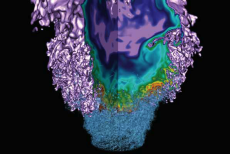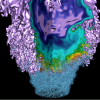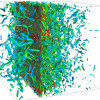Engineering Science
Researchers in this area develop and apply a variety of advanced computational methodologies for solving large-scale complex fluid flow problems with turbulence and/or shock physics. These problems arrise in Department of Energy (DOE) mission areas related to energy, environmental, and industrial technology.
The work is fundamental in nature and seeks to elucidate the underlying physics of these processes; this will then eventually lead to better engineering models.
The diverse range of scientific applications that drive this research typically involve large spatial and temporal scales (e.g., turbulent reacting flows) and always require use of extremely large computing hardware, such as the 150,000-core Hopper system at NERSC.
Advanced Computational Methods for Turbulence and Combustion
Simulation of practical-scale combustion devices is an immense undertaking but the work has enormous implications and NERSC researchers have developed techniques applicable to small-scale and laboratory-scale flames that operate on a wide variety of fuel mixtures. Read More »
Compressible Turbulence and Interactions with Shock Waves and Material Interfaces
Shock/turbulence interaction is a fundamental phenomenon in fluid mechanics that occurs in a wide range of interesting problems in various disciplines, including supernova explosions, inertial confinement fusion, hypersonic flight and propulsion, and shock wave lithotripsy. Read More »










